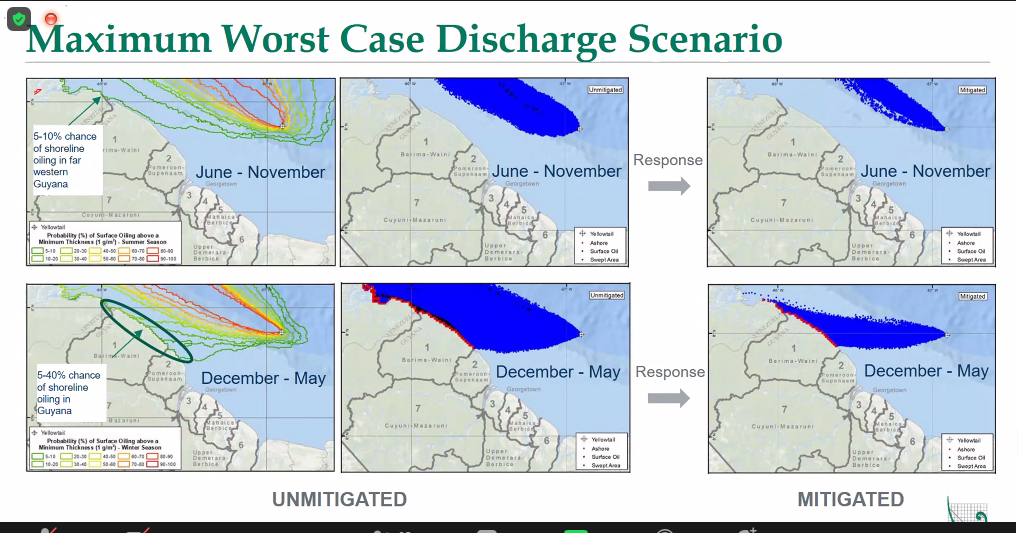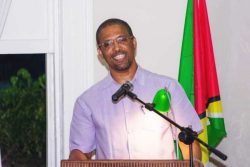With ExxonMobil ramping up activities offshore Guyana and the government granting more permits to advance the process, a group of environmental activists have written to Chair of the Caribbean Community (CARICOM) Belizean Prime Minister Johnny Briceño outlining possible risks of the operations.
In a letter, dated April 8, 2022 and seen by Sunday Stabroek, activists Darshanand Khusial of the Oil and Gas Governance Network (OGGN) along with Vincent Adams, Alfred Bhulai, Janette Bulkan, Darshanand Khusial, Joe Persaud, Mike Persaud, Ganga Ramdas, and Charles Sugrim called for CARICOM’s intervention.
The letter informed that while the group supports petroleum production in Guyana, it must be done in a manner that is protective of the region’s environment, safety and health, and economic wellbeing.
“To this end, we urge CARICOM to engage the GoG [Government of Guyana] to ensure that oil operations offshore Guyana, are carried out in a safe and environmentally sound manner. Failure to do so could devastate the region’s economy and environment.
“Specifically, we request that: (1) CARICOM demands that the GoG immediately take actions to enforce the legal requirements of the EIAs and Environmental Permits; (2) CARICOM demands that the GoG stop EEPGL from dumping hot, toxic and radioactively contaminated produced water into the Caribbean Sea; (3) CARICOM demands that the GoG reverse its decision to allow unlimited flaring for a small fine and return to the original regulation where “routine flaring or venting is prohibited”; and (4) CARICOM engages the GoG on ensuring its petroleum extraction laws and regulations are compatible with the 2016 Paris Agreement,” the letter stated.
The group outlined a number of issues with the offshore operations that the government has failed to address significantly. Key among those was the transboundary risks to the Caribbean should there be a large oil spill in Guyana’s Exclusive Economic Zone (EEZ).
According to ExxonMobil’s environmental studies, should there be a significant spill activity in the Stabroek Block then approximately 11 Caribbean and South American territories stand to be affected. Trinidad and Tobago, Venezuela, Grenada, St Vincent and the Grenadines, Bonaire, Curacao, Aruba, the Dominican Republic, Haiti, Jamaica and Colombia are some of the countries that could be affected, the latest Environmental Impact Assessment for Exxon’s largest development – Yellowtail – states.
Yellowtail was granted its environmental permit on March 30 and its production licence two days later by the Environmental Protection Agency and Ministry of Natural Resources respectively. The move has been heavily criticised by some environmentalists since they are contending that Exxon fails to address key environmental concerns.
In their letter, the activists informed the CARICOM Chair that they are concerned about the lack of public information on transboundary engagements with respect to the Caribbean Sea and the complete lack of transparency exhibited by the government of Guyana and Exxon. They noted that repeated requests for information on the transboundary impacts were met with silence by the government and operator of Guyana’s Stabroek Block.
“EEPGL’s (Esso Exploration and Production Guyana Limited) breakneck drilling of exploration and production wells is currently concentrated inside the northern edge of Guyana’s Exclusive Economic Zone (EEZ). This puts the potential for transboundary harms closer to several CARICOM Member States than to the Guyana shoreline. We request specific information on the steps being taken to honour the separate commitments by our countries to safeguard the global environment: namely, the precautionary-2, preventive-3, and the common concern of humankind principles.
“ERM’s maps of models of oil spills are included in the EIA volumes for each of the first four oil fields being developed in the Stabroek Tract, confirming EEPGL’s trust in these simulations. These four fields are Liza-1 and Liza-2, both in current production; Payara under development; and Yellowtail under exploration and planning, and recently given a contested environmental permit (on March 30, 2022). The oil spill response plan has been criticized as weak by international specialist Robert Bea, considering the problems which have arisen in US oil fields,” the letter said.
In that regard, the group requested that the CARICOM Chair aid them with information relating to the “transboundary workgroup” EEPGL committed to creating in 2017 in one of its EIAs. Additionally, they sought information on CARICOM’s internal processes for dealing with the actions of a member State which have implications for transboundary harms.
In driving home the issue of transboundary harm, the activists raised the issue of the risk of massive uncontrolled oil spills from deep high-pressure wells similar to the Macondo well in the Gulf of Mexico in 2010; dumping vast quantities of heated contaminated ‘produced’ water and cooling water, and flaring of associated gas in these offshore oil fields.
It informed the CARICOM Chair of Exxon’s consistent flaring of natural gas offshore Guyana with very little care. They noted that from December 2019 to date, Exxon has flared in excess of 15 billion standard cubic feet of natural gas as opposed to cutting production by 3% to stop the flaring. They also pointed out that the government has changed the permits to pave the way for this flaring.
The group explained the harmful impacts of the produced water being discharged offshore Guyana.
“Based upon the EIAs projected discharge rates of ≤ 300,000 barrels per day (BPD) each, and XOM’s [ExxonMobil] publicly stating stated plan to have 10 FPSOs operating by 2027, it is conservatively estimated that hundreds of thousands of barrels of pure oil would be dumped into the ocean over the life of the oil operations predicted to be at least 20 years; and this does not consider the other many operators expected to start production in the near future. When added to a potential oil spill, this dumping will compound the Caribbean region’s worries about the resulting devastating impacts to our ecological systems and fishing and tourist industries,” the letter said.
It added that the permit also allows for the discharged water to heat the surrounding ocean by up to 3 degrees Celsius above ambient water temperature at 100 metres from the FPSO and 55 degrees celsius at the FPSO discharge point – at least twice the temperature of the ambient ocean water.
“These discharges are not consistent with the application of the United Nations’ Precautionary Principle when Caribbean fish stocks are already facing critical temperature challenges,” it said.









